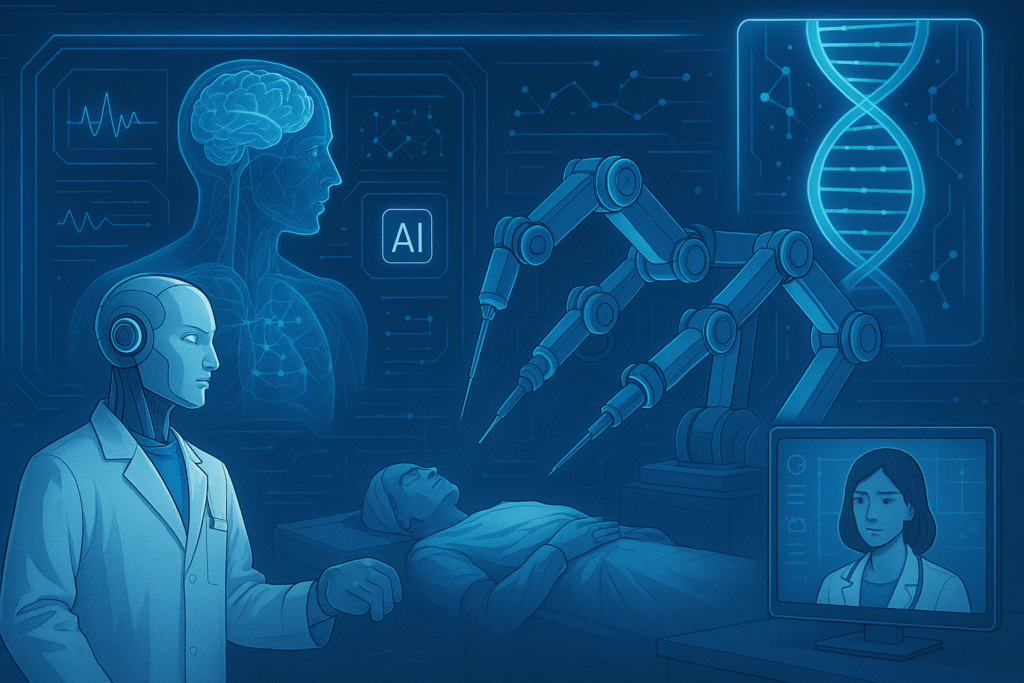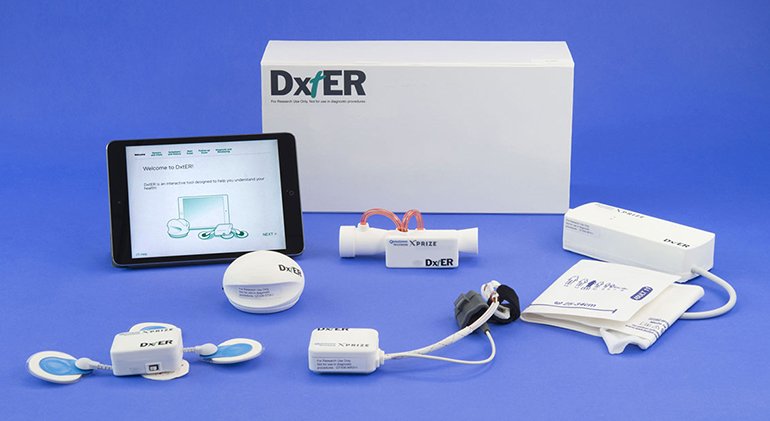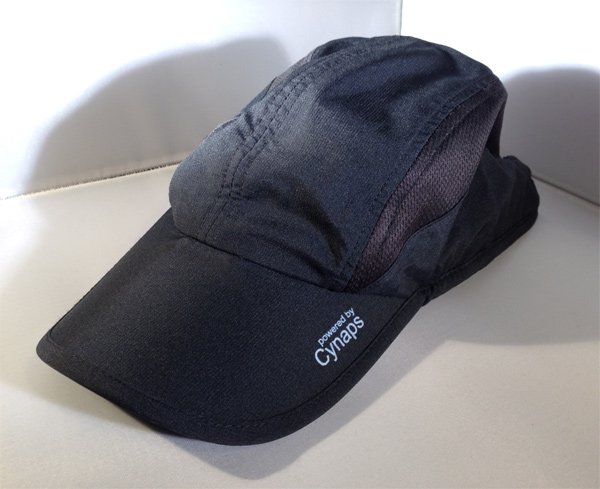This is GizmoMD
Dear Friends, It’s been a while. If you’ve been wondering what happened to Medgadget — you’re not alone. It’s been a few years since anything was published, and like many of you, I’ve missed the excitement of discovering and sharing the latest in…
The Latest
AI-Guided Brain Stimulation Boosts Focus Safely at Home
A team from the University of Surrey, University of Oxford, and Cognitive Neurotechnology has created a personalized brain stimulation system that enhances concentration using artificial intelligence and non-invasive electrical pulses. The system uses transcranial random noise stimulation (tRNS), a gentle form of brain stimulation, paired with an AI algorithm that adjusts intensity based on individual traits like head size and baseline attention levels. The technology was tested in a double-blind study involving 37 participants and trained on data from 103 individuals who completed 290 home-based sessions using CE-certified headgear and tablet-based attention tasks. Those receiving AI-personalized stimulation showed significantly better…
Smartphone-Readable Biosensor Measures Cortisol with High Sensitivity
At the University of California Santa Cruz, biomolecular engineer Andy Yeh has developed a luminescent biosensor that detects cortisol—the body’s primary stress hormone—with unprecedented sensitivity and dynamic range. Cortisol regulates blood pressure, metabolism, and immune response, and imbalances are linked to conditions like chronic fatigue, depression, and adrenal disorders. Traditional cortisol tests require lab equipment and offer limited accuracy outside normal ranges. Yeh’s biosensor uses two artificially designed proteins that bind to cortisol and emit light when activated. The amount and color of light correlate directly with cortisol concentration. This signal can be captured using a smartphone camera, enabling point-of-care…
Microcone Device Captures Cancer Cells from Blood with 90% Efficiency
Researchers at Chiba University have developed a microfluidic device that uses nanoimprinted microcone arrays to detect circulating tumor cells (CTCs) in blood with high sensitivity and efficiency. CTCs are cancer cells that break away from primary tumors and travel through the bloodstream, potentially causing secondary tumors. Detecting them early is crucial for diagnosis, treatment monitoring, and recurrence prevention—but traditional methods are often invasive, expensive, or lack precision. The team, led by Professor Masumi Yamada, fabricated microcones on polycarbonate sheets using thermal nanoimprint lithography (T-NIL). These microcones, roughly 30 micrometers in size and arranged in hexagonal patterns, were coated with antibodies…
Whole-Brain Organoid Models Early Neural Development
Johns Hopkins researchers have developed a multi-region brain organoid (MRBO) that integrates cerebral, midbrain, hindbrain, and vascular tissues. Unlike traditional organoids that model isolated brain regions, the MRBO mimics a 40-day-old fetal brain and exhibits coordinated electrical activity across regions. It also forms a rudimentary blood-brain barrier, a critical feature for studying drug permeability and neurodevelopment. The organoid contains 6–7 million neurons and represents 80% of the cell types found in early brain development. To create it, researchers grew separate regional tissues and fused them using sticky proteins, allowing the cells to connect and function as a unified network. This…
Yogurt-Derived Gel Promotes Tissue Healing
Columbia University engineers have created an injectable hydrogel using extracellular vesicles (EVs) extracted from yogurt. EVs are nanoscale particles secreted by cells that carry proteins, RNA, and other bioactive molecules. In this study, EVs serve a dual purpose: they act as structural crosslinkers and deliver regenerative signals, enabling the gel to mimic living tissue and promote healing. The hydrogel is formed by crosslinking biocompatible polymers with EVs, creating a stable, bioactive material that can be injected directly into damaged tissue. In mouse models, the gel triggered angiogenesis and anti-inflammatory immune responses within one week, accelerating tissue regeneration without additional chemical…
Online Reaction Test Detects Toxoplasmosis Without Blood
An international team led by the University of Melbourne has developed a non-invasive online test that detects latent toxoplasmosis infection by analyzing subtle changes in reaction time. The test is especially effective in individuals with RhD-negative blood types, where infection with Toxoplasma gondii—a common parasite—slows reaction times by fractions of a second. Though imperceptible to the individual, these delays are measurable and statistically significant. Toxoplasmosis affects roughly 30% of the global population and is typically contracted through undercooked meat or exposure to cat feces. While often asymptomatic, the parasite can alter dopamine regulation, influencing behavior, impulsivity, and mental health. Previous studies…
Light-Activated Drug Targets Resistant Cancer Cells
Researchers at Northeastern University have developed a novel photoimmunotherapy technique that uses near-infrared light to activate a drug bound to an antibody targeting melanotransferrin (MTf), a protein found in melanoma and triple-negative breast cancer. These cancers are notoriously resistant to conventional chemotherapy, which often causes systemic toxicity and adverse side effects. The new approach offers a highly targeted alternative by combining antibody specificity with light-triggered activation. The therapy hinges on a SNAP-tag protein that links a light-sensitive drug to an antibody designed to bind MTf. Once the antibody-drug complex reaches the tumor site, near-infrared light activates the drug, producing reactive…
Biosensor Capsule Offers At-Home IBD Monitoring
Researchers at Mass General Brigham and the University of Toronto have developed a swallowable biosensor pill called PRIM (Pill for ROS-responsive Inflammation Monitoring) that detects intestinal inflammation by releasing a visible blue dye in response to elevated levels of reactive oxygen species (ROS)—a chemical marker associated with inflammatory bowel diseases (IBD) like Crohn’s and ulcerative colitis. The pill is coated with a ROS-sensitive polymer that remains stable under healthy conditions but breaks down when inflammation is present. Once the polymer degrades, the capsule releases Brilliant Blue FCF dye, which colors stool and toilet water, providing a clear, at-home visual signal…
Virtual Cell Lab Simulates Biology in Real Time
Researchers from Johns Hopkins Medicine, Indiana University, the University of Maryland School of Medicine, and Oregon Health & Science University have developed a powerful new computational platform that simulates the behavior of living cells—offering a virtual testing ground for biological research, drug development, and disease modeling. The system, built on an upgraded version of the PhysiCell software, uses agent-based modeling to represent each cell as a “math robot” governed by rules derived from DNA, RNA, and environmental factors. This virtual cell lab allows scientists to observe how cells interact, form tissues, respond to therapies, and evolve over time—without the need…
Magnet-Guided, Light-Triggered Drug Delivery System for Precision Cancer Treatment
Researchers at the University of Illinois Urbana-Champaign have developed a precision drug delivery system that combines magnetic steering with light-triggered release, offering a new approach to targeted therapies—especially for cancer. The system uses lipid vesicles, which are microscopic containers similar in structure to cells, to carry drugs. These vesicles are engineered to encapsulate superparamagnetic particles, allowing them to be guided through fluid environments using external magnetic fields. The innovation solves a major challenge in targeted drug delivery: how to direct therapeutic agents to specific sites in the body without affecting surrounding tissue. By using magnetic fields—like those generated by MRI…



















